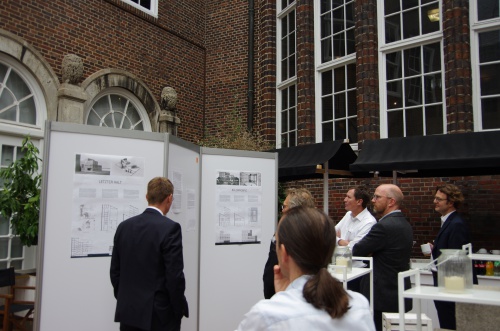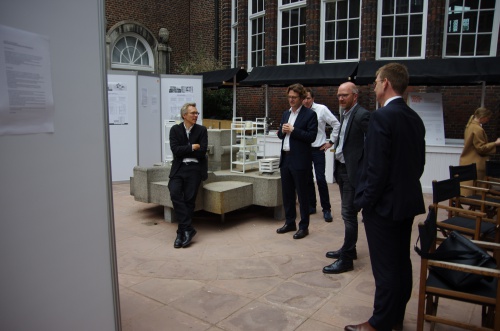Winner and special prize chosen: euroterra. Architecture Award for Young Designers
“Emotional quality in the coherence of planning”, “Design and execution with a focus on residents”, “High level of adequacy” and “People. Space. Time. have found a creative equivalent here” were the verdicts of the judges who, on 1st and 2nd October 2020, assessed the applications received for the euroterra. Architecture Award for Young Designers “People. Space. Time. - Functional Architecture of Buildings in the Healthcare Sector/Hospital Construction” in Hamburg.
When we announced the award at the end of 2019, we had no idea of the pandemic-related challenges that would follow for some time shortly after the award was announced in early March 2020 and that still continue. Therefore, we were very pleased that we were able to arouse interest in the euroterra. Architecture Award despite the restrictions in the daily office routine of many planning companies and in the daily study routine of students, and that we received applications for the award from all over Europe. The judging panel, consisting of
- Frank Engelbrecht,
Pastor at St. Katharinen Church in Hamburg, - Professor Jürgen Graf,
Medical Director and Chair of the Executive Board, Frankfurt University Clinic, - Dipl.-Ing. Architect Daniel Kinz,
Gössler Kinz Kerber Schippmann Architekten BDA and 1st Chairman of Bund Deutscher Architekten und Architektinnen der Freien und Hansestadt Hamburg e.V., - Dr Frank Mau,
Managing Director, Evangelische Kliniken Essen-Mitte, - Joachim Prölss,
Chair and Director for Patient and Care Management, University Medical Center Hamburg-Eppendorf, - Dipl.-Ing. Architect and Civil Engineer Marc Ewers,
Managing Director of euroterra. architekten ingenieure,
was thus able to review eight very individual and interesting projects by young planning companies that had been selected for participation, choose two as prize winners and also award a special prize.
During the panel’s deliberations on which specific criteria to use for the “People. Space. Time. - Functional Architecture of Buildings in the Healthcare Sector /Hospital Construction” projects to be evaluated, they came to the unanimous decision that, in addition to ecological, socio-cultural, functional, process and location quality, the “change of perspective” from the planners had to ultimately be recognisable in order to understand the needs of the users (or processes), of the people – on the one hand as functionaries, on the other hand as individuals – and to be able to take them into account and implement them in the planning of hospital and health care buildings. This change of perspective is reflected in an “emotional quality”, which should also be taken into account as a criterion for evaluating the projects. This includes the emotional or psychological effect of the projects on the assessors or each individual judge on the one hand, and on the other hand, after implementation of the building projects, on the different user groups, i.e. well-being or discomfort due to critical assessment of spaces or also the perception with regard to colour design, choice of materials, dimensions, integration into the spatial environment, use of light, sound impression, exposure to fresh air, “human scale” proportions, or the like.
During two evaluation rounds and consideration of the decisive criteria, the judging panel decided that the new heilpädagogischen Förderzentrums Friedrichshulde (Friedrichshulde Remedial Education Centre) building (HTT ARCHITEKTEN GbR, c/o BUSCH & TAKASAKI Architekten, Schönstedtstr. 7, 12043 Berlin, Germany) fully meets the criteria and unanimously selected the project as the first-place winner with the following assessment:
The winning design by HTT ARCHITEKTEN for the new building of the heilpädagogischen Förderzentrums Friedrichshulde e.V. particularly impressed the panel.
Following the guiding idea of “People. Space. Time. - Functional Architecture of Buildings in the Healthcare Sector /Hospital Construction”, the winning design successfully developed the use of the property ecologically, socio-culturally and functionally, and yet not spatially removed. Here, the reference spaces of the overall complex are incorporated in an ensemble design. The architectural design of the houses and rooms was planned with the future in mind and with a flexible spatial adaptation concept. The sustainable timber design chosen deliberately blends perfectly into the natural property with its old trees.
The plans and the photographically depicted structural development steps show a correspondingly pleasing and elegant embedding of a technically and economically cleverly chosen and sustainably executed basic structure in timber frame construction in the context of the local area. The reduction of road surfaces overall leads to a prominent pick-up and drop-off location with two parking facilities in the east of the site. The panel’s only criticism is that the plan documents or the supplementary textual description do not address the chosen placement of the road surfaces. Perhaps the approach here is important in terms of the recurring picking-up (and dropping-off) of residents and therefore also being emotionally central, or else being seen as part of the function of the site and therefore of a functional nature.
One of the particular strengths and decisive factors for the design’s first-place ranking is the emotional quality that has emerged, which is not exemplified by individual aspects, but comes to fruition in the coherence of the planning, design and execution with a focus on the residents, the use and the surroundings.
People. Space. Time. have found a creative equivalent here.
The judging panel voted for the hospice, Cittadella dell’Immacolata Hospice of Bagnara Calabra (Paola Elena Maghenzani, Viale della Cavallaria 15, 73100 Lecce, Italy) as the project in second place and said:
“The judging panel of the euroterra Architecture Award has decided to award the hospice project, Citadella dell‘Immacolata, second place in the competition. The project is impressive with respect to a number of the specified evaluation criteria. From the panel’s point of view, the quality of the location and the emotional quality deserve special mention. In consultation with the commissioning local authorities, the planner has chosen a site for the planned hospice that is characterised by an extremely picturesque landscape with lush Mediterranean vegetation with olives, vines and views over the Tyrrhenian Sea. The architect is planning a complex that is nestled like a monastery in what she herself describes as an almost mystical landscape – a mixture of the Gardens of Eden and Gethsemane. In this topography, the proposed architecture makes the juxtaposition of life and death perceptible to the senses and thus possibly opens doors for the acceptance of our own vulnerability, suffering, mortality and death. Those responsible for the project do not only have the patients and professional staff in mind, but also families and loved ones, whom the project explicitly understands as irreplaceable participants in the process of healing or bereavement. This is also reflected in the architecture, which offers indoor and outdoor spaces in equal measure for professional staff, relatives and patients. This is also where the project’s distinctive socio-cultural and functional qualities lie, in that the architecture focuses on the interaction of all participants with the landscape and history of the site. Critical questions arose in the panel regarding the architectural decision to house the rooms for bereavement and also transportation of the deceased in the basement. The basement levels underpin the house by filling the landscape depression over which the hospice is to be built. Certainly, in this way, a perhaps intended seclusion and intimacy is created, which may help those affected with the topic of death. However, this is somewhat at odds with the otherwise practised transparency and openness with which the project approaches the topic of life and death.
The jury assessed the economic quality of the project positively. Economic sustainability is ensured by the planned modular construction, which should allow for the future conversion and further development of individual rooms as well as the entire facility. This gives plenty of room for the innovative further development of the project in terms of content and space.
In conclusion, the panel decided that the project was certainly worthy of an award. The criticisms made do not detract from this as they are to be understood as an expression of open-minded curiosity that, stimulated by the project, would have liked to know even more and felt inspired to think further independently.
With this in mind, the euroterra. Architecture Award judging panel is pleased to award the Hospice – Citadella dell‘Immacolata the second prize in this competition.”
Due to the special subject matter and appropriate project presentation “Refugium Regenerativum”, the judging panel, in consultation with the awarding authority, awarded a special prize to Philipp Knaus, Master’s degree in Architecture, 4th semester at the Technical University of Braunschweig, Institute for Constructive Design, Industrial and Health Construction, and explained the reasons for their decision as follows:
“The design for a “Refugium Regenerativum” deals with the question of how health care could be provided in less developed countries in a way that, in addition to simple treatment, also takes into account the living conditions and social circumstances of the patients.
Based on the idea that such a hospital building should be constructed with local building materials by local, possibly not extensively trained craftsmen, the work results in a single-storey complex with clearly legible, different areas of use. An emergency department, operating areas with a well thought-out layout and a maternity ward are included, in addition to the patient rooms.
The patient rooms are planned as multi-bed rooms – quite unusual for the so-called first world – without their own water supply. These proposals are in response to the local situation, where the use of the water supply is to be reserved for all patients and separated from the numerous visitors. Family members caring for the patients poses another challenge, which is logically reflected in the architectural stance. The wings of the facility form inner courtyards where lounging areas are available and sufficient space is provided for patients and visitors.
The project is characterised by a high degree of suitability. Partly openwork brick walls, open timber structures and sloping roofs, which are detached from the actual treatment room in some areas to prevent overheating, create an inspiring, regionally connected and uncluttered atmosphere. A successful contribution that puts people at the centre and impressively works through an important topic.”
We congratulate the award winners and would like to thank all applicants and the judging panel for this constructive and thoughtful deliberation. Due to the ongoing Covid-19 pandemic, we have been advised to postpone the celebratory award ceremony until early summer 2021 and are already looking forward to welcoming the winners, applicants and judges of the euroterra. Architecture Award in Hamburg.



